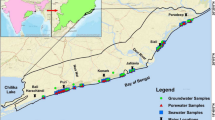Abstract
In order to reveal the temperature variation mechanism of a small and relatively closed cave, the surface temperature, the cave air temperature and the drip water temperatures were monitored with high-resolution recorders for a 7-year period. The results indicated that the cave temperature is mainly affected by the external seasonal oscillations. The temperature curve of the inner cave area (with standard deviation between 0.59 and 0.87) was much smoother in comparison with that of the surface (with SD as high as 8.46). However, the cave reacted to the temperature drifts with some delay, for example, at VP3 in 2006, the internal temperature increased for additional 49 days after the surface temperature dropped colder than inside of the cave. This seasonal variation and delayed response of the internal temperature were mainly affected by conduction from the epikarst rock mass. Air convection also occurred in the cave, especially when the surface temperature dropped lower than that of the inside cave (during the winter time) and in the outer section (close to the entrance), which caused an abrupt and irregular variation of the outer section. In addition, the influence from the percolating water was ephemeral and depended on its supplementary amount and temperature difference, e.g., there were more apparent responses at VP1 and VP3 when the intensive rain fell. The percolating water temperature could be a good indicator for water flow in epikarst.






Similar content being viewed by others
References
Anderson MP (2005) Heat as a ground water tracer. Groundwater 43(6):951–968. doi:10.1111/j.1745-6584.2005.00052.x
Asrat A, Baker A, Leng MJ, Gunn J, Umer M (2008) Environmental monitoring in the Mechara caves, Southeastern Ethiopia: implications for speleothem palaeoclimate studies. Int J Speleol 37(3):207–220. doi:10.5038/1827-806X.37.3.5
Badino G (2004) Cave temperatures and global climatic change. Int J Speleol 33(1/4):103–114. doi:10.5038/1827-806X.33.1.10
Bourges F, Genthon P, Genty D, Lorblanchet M, Mauduit E, D’Hulst D (2014) Conservation of prehistoric caves and stability of their inner climate: lessons from Chauvet and other French caves. Sci Total Environ 493:79–91. doi:10.1016/j.scitotenv.2014.05.137
Brancelj A (2002) Microdistribution and high diversity of copepoda (Crustacea) in a small cave in central Slovenia. Hydrobiologia 477(1–3):59–72. doi:10.1023/A:1021043014879
Bundschuh J (1993) Modeling heat transport from the earth’s surface through aquifers to springs: theoretical examples and case studies. Proceedings of the Yokohama Symposium, IAHS Publish, pp 212
Covington MD, Luhmann AJ, Gabrovšek F, Saar MO, Wicks CM (2011) Mechanisms of heat exchange between water and rock in karst conduits. Water Resour Res 47(10):1–18. doi:10.1029/2011WR010683
Cronaton F, Perrochet P (2002) Analytical 1D dual-porosity equivalent solutions to 3D discrete single-continuum models. J Hydrol 262(1–4):165–176. doi:10.1016/S0022-1694(02)00033-1
Faimon J, Troppova D, Baldikb V, Novotny R (2012) Air circulation and its impact on microclimatic variables in the C’ısarska Cave (Moravian Karst, Czech Republic). Int J Climatol 32:599–623. doi:10.1002/joc.2298
Ford D, Williams P (2007) Karst hydrogeology and geomorphology. Wiley, New York
Genthon P, Bataille A, Fromant A, Dhulst D, Bourges F (2005) Temperature as a marker for karstic waters hydrodynamics. Inferences from 1 year recording at La Peyrére cave (Ariège, France). J Hydrol 311(1–4):157–171. doi:10.1016/j.jhydrol.2005.01.015
Genty D (2008) Palaeoclimate research in Villars Cave (Dordogne, SW-France). Int J Speleol 37:173–191. doi:10.5038/1827-806X.37.3.3
Genty D, Baker A, Vokal B (2001) Intra- and inter-annual growth rate of modern stalagmites. Chem Geol 176:191–212. doi:10.1016/S0009-2541(00)00399-5
Jeannin PY, Liedl R, Sauter M (1997) Some concepts about heat transfer in karstic systems. Proceedings of the 12th International Congress of Speleology 1: 195–198
Jeannin PY, Groves C, Hauselmann P (2007) Speleological investigations. In: Goldscheider N, Drew D (eds) Methods in karst hydrogeology. Taylor &Francis, Leiden, pp. 25–44
Liedl R, Sauter M, Huckinghaus D, Clemens T, Teutsch G (2003) Simulation of the development of karst aquifers using a coupled continuum pipe flow model. Water Resour Res 39(3):1057–1062. doi:10.1029/2001WR001206
Liu WA, Brancelj A, Brencic M (2014) The hydrochemical response of cave drip waters to different rain patterns (a case study from Velika Pasica Cave, central Slovenia). Carpath J Earth Env 9(1):189–197
Liu WA, Brancelj A, Ellis Burnet J (2016) Interpretation of cave drip water recession curves, a case study from Velika Pasica Cave, central Slovenia. Hydrolog Sci J. doi:10.1080/02626667.2016.1154150
Luhmann AJ, Covington M, Peters AJ, Alexander SC, Anger CT, Green JA, Runkel AC, Alexander EC Jr (2011) Classification of thermal patterns at karst springs and cave streams. Groundwater 49(3):324–335. doi:10.1111/j.1745-6584.2010.00737.x
Pleničar M (1970) Tolmač k Osnovni geološki karti SFRJ, List Postojna. Zvezni geološki zavod Beograd. (= Basic geological survey; section Postojna)
Sanderson K, Bourne S (2002) Cave temperatures at Naracoorte caves. Helictite 38(1):7–10
Šebela S, Turk J (2011) Local characteristics of Postojna Cave climate, air temperature, and pressure monitoring. Theor Appl Climatol 105:371–386. doi:10.1007/s00704-011-0397-9
Stoeva P, Stoev A, Kiskinova N (2006) Long-term changes in the cave atmosphere air temperature as a result of periodic heliophysical processes. Phys Chem Earth 31:123–128. doi:10.1016/j.pce.2005.05.001
Thakur AKS, Momoh MM (1983) Temperature variation in upper earth crust due to periodic nature of solar insolation. Energ Convers Manage 23(3):131–134. doi:10.1016/0196-8904(83)90054-7
Acknowledgements
Authors would like to thank the Slovenian Research Agency for funds within the program P1-0255 and within the program for Young Researchers (Contract no. 1000-11-310196). Special thanks to Dr. Matthew Covington for his advice on the original thought of this manuscript. Sincere thanks to Prof. Dr. Julia Ellis Burnet for English editing.
Author information
Authors and Affiliations
Corresponding author
Rights and permissions
About this article
Cite this article
Liu, W., Zhou, C., Liu, Z. et al. The temperature variation in an epikarstic cave and its impact factors: a case from Velika Pasica Cave, Central Slovenia. Arab J Geosci 10, 2 (2017). https://doi.org/10.1007/s12517-016-2761-7
Received:
Accepted:
Published:
DOI: https://doi.org/10.1007/s12517-016-2761-7




